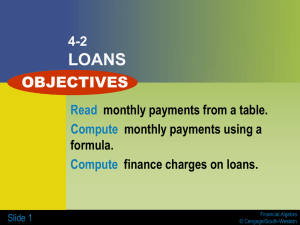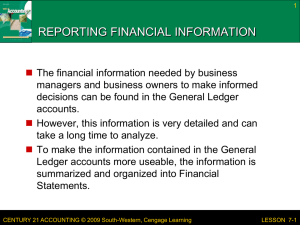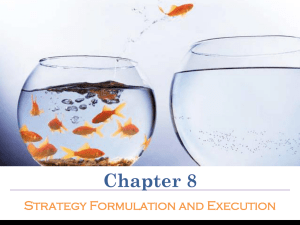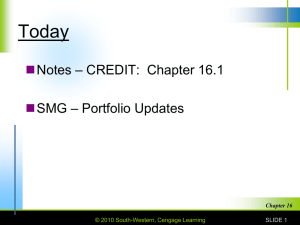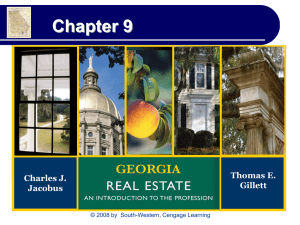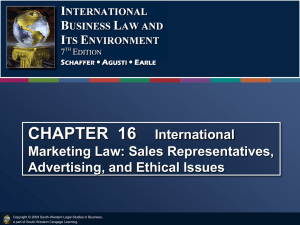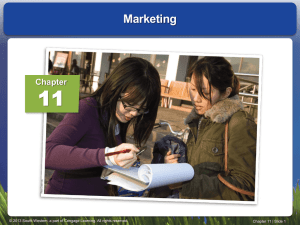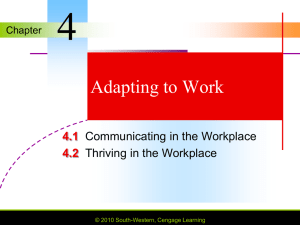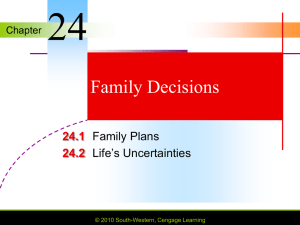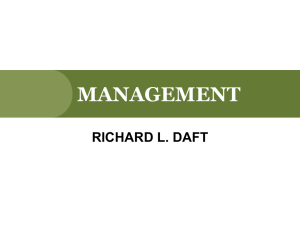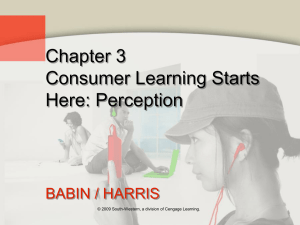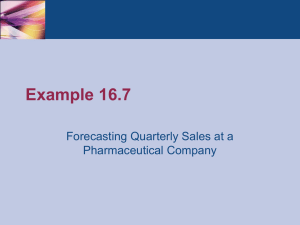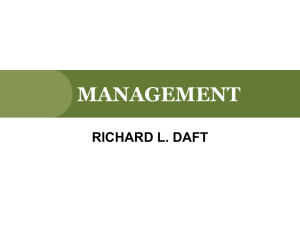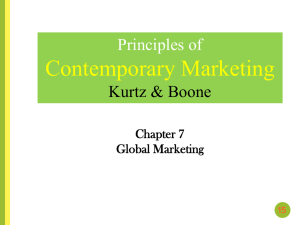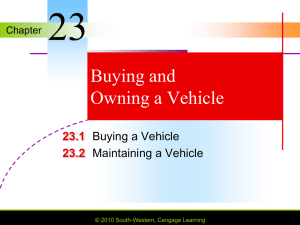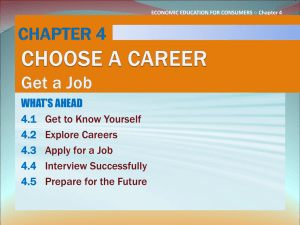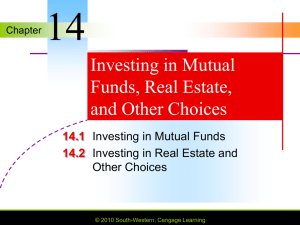Credit Notes
advertisement
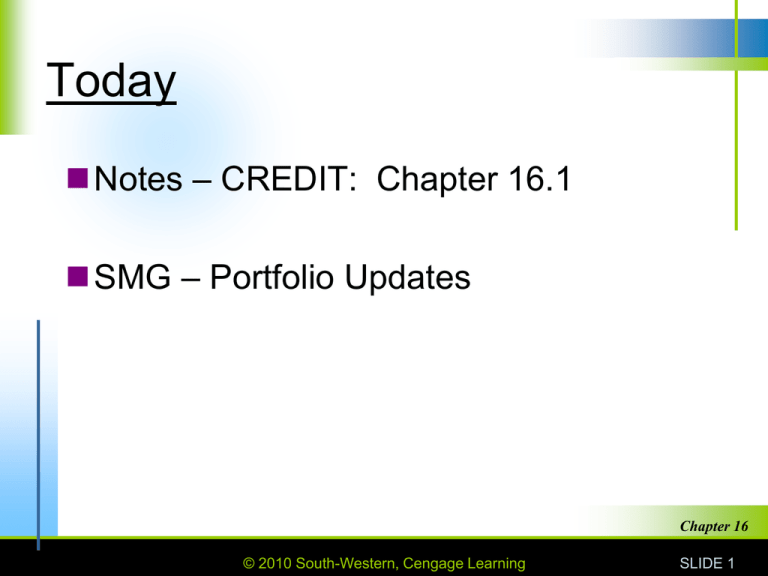
Today Notes – CREDIT: Chapter 16.1 SMG – Portfolio Updates Chapter 16 © 2010 South-Western, Cengage Learning SLIDE 1 Chapter 16 Credit in America 16.1 Credit: What and Why 16.2 Types and Sources of Credit © 2010 South-Western, Cengage Learning Learning Targets Discuss the history of credit and the role of credit today. List and Explain advantages and disadvantages of using credit. Chapter 16 © 2010 South-Western, Cengage Learning SLIDE 3 KEY TERMS Credit Debtor Creditor Capital Collateral Finance Charge Line of Credit Deferred Billing Chapter 16 © 2010 South-Western, Cengage Learning SLIDE 4 The Need for Credit Credit is the use of someone else’s money. borrowed now with the agreement to pay it back later at a cost (typically interest) Early forms of credit started with Farmers Credit today Merchants, Retail, Wholesale, etc. Credit has become a way of life! © 2010 South-Western, Cengage Learning Chapter 16 SLIDE 5 The Use of Credit A debtor is a person who borrows money from others. This money, called debt, must be repaid. A creditor is a person or business that loans money to others. Creditors charge money for this service in the form of interest and fees. A debtor must be qualified to receive credit. Current economic crisis is due to this practice not being followed. Chapter 16 © 2010 South-Western, Cengage Learning SLIDE 6 Qualifying for Credit To qualify for credit, you must have the ability to repay the loan. Qualification is typically based on four things: Income Financial position Collateral Personal History Chapter 16 © 2010 South-Western, Cengage Learning SLIDE 7 Income Sources of income include: Job Interest Dividends Alimony Royalties Income represents cash inflow. When your earnings exceed your expenses, you have the capacity to take on debt. Chapter 16 © 2010 South-Western, Cengage Learning SLIDE 8 Financial Position Capital is the value of property you possess after deducting your debts. Capital Examples Bank Accounts Investments Real estate Other assets with unbiased value after deducting your debts. Having capital = responsibility and monetary value. Cash Outflow (Debt) will be compared to your Cash Inflow (Income). Chapter 16 © 2010 South-Western, Cengage Learning SLIDE 9 Collateral Collateral is property pledged to assure repayment of a loan. To borrow large amounts of money, creditors often want more than just your promise to repay; they want collateral. If you do not make your loan payments, the creditor can seize the pledged property. Repossession - Example You buy a new 60in HDTV from Best Buy using a credit card. You do not make your payments for an extended period of time. Collection agency gets involved: Call you at work/home trying to collect the debt. Come and get the item you have defaulted payment on. Chapter 16 © 2010 South-Western, Cengage Learning SLIDE 10 Making Payments Swiping your Credit Card = you owe money! Principal (amount borrowed) plus interest for the time you have the loan is called the Balance Due. Finance Charge is the total dollar amount of all interest and fees you pay for the use of credit. Minimum Payment is the least amount of money you have to pay per your monthly statement. Always pay more than the minimum due amount. Chapter 16 © 2010 South-Western, Cengage Learning SLIDE 11 Credit Advantages Disadvantages Increased Purchasing Power Emergency Funds Convenience Deferred Billing Proof of Purchase (records) Safety Higher Costs Finance Charges Overspending Tie Up Future Income Chapter 16 © 2010 South-Western, Cengage Learning SLIDE 12 Assignments: Key Terms Review pg. 362 Questions: 1 – 8 Check Your Understanding pg. 362 Question: 10 Apply Your Knowledge pg. 362 Question: 11 Chapter 16 © 2010 South-Western, Cengage Learning SLIDE 13 Monday, Dec. 1st Transaction Register – Week 3 Drake – missing week 2 Dre – missing week 2 Basketball Game Scheduling: Sign-Up (must be done today) Get Camera, Chargers and Tripods Tomorrow Notes – Types and Sources of Credit Chapter 16 © 2010 South-Western, Cengage Learning SLIDE 14 Types and Sources of Credit Learning Targets List and describe the types of credit available to consumers. Describe and compare sources of credit. Chapter 16 © 2010 South-Western, Cengage Learning SLIDE 15 KEY TERMS Open-End Credit APR Grace Period Closed-End Credit Service Credit Finance Company Loan Sharks Usury Law Pawnbroker Chapter 16 © 2010 South-Western, Cengage Learning SLIDE 16 Types of Credit Open-end credit Closed-end credit Service credit Chapter 16 © 2010 South-Western, Cengage Learning SLIDE 17 Open-End Credit Open-end credit is where a borrower can use credit up to a stated limit. Charge Cards Master Card Visa Discover American Express American Eagle Sears Kohl’s Best Buy NOTE – Charge Cards are types of “Revolving Credit” Chapter 16 © 2010 South-Western, Cengage Learning SLIDE 18 Credit Card Agreements the terms of the credit card agreement affect the overall cost of the credit you will be using. APR – Annual Percentage Rate Grace Period Billing Cycle Finance Charge Fees – Processing, Transaction, Transfer, Late, Cash Advance, Currency Conversion, Over Credit Limit, etc. Chapter 16 © 2010 South-Western, Cengage Learning SLIDE 19 Closed-End Credit Closed-end credit (also called Installment Credit) is a loan for a specific amount that must be repaid in full, including all finance charges, by a stated due date. Payment Booklet Set Due Date Interest Included in Payment Amounts Examples Cars Furniture Major Appliances Home Mortgages Chapter 16 © 2010 South-Western, Cengage Learning SLIDE 20 Service Credit Service credit involves providing a service for which you will pay later. Examples: Utility services Phone services Cable/Satellite TV services Examples of businesses that extend service credit: Doctors Dentists Lawyers Dry Cleaners Auto Repair Shops Terms are set by individual businesses. Chapter 16 © 2010 South-Western, Cengage Learning SLIDE 21 Sources of Credit Retail stores Credit card companies Banks and credit unions Finance companies Pawnbrokers Private lenders Other sources of credit Remember it is NOT FREE – consumers pay for it. Chapter 16 © 2010 South-Western, Cengage Learning SLIDE 22 Retail Stores Examples Department stores Discount stores Specialty stores. Many retail stores offer their own credit cards. These cards are accepted only at the issuing store. Advantages Receive Discounts Advance notice of sales Receive Gift Cards Disadvantages Very High Interest Rates Can only use them there Most retail stores also accept credit cards issued by major credit card companies. Chapter 16 © 2010 South-Western, Cengage Learning SLIDE 23 Credit Card Companies Credit Card Issuers Examples - Visa, MasterCard, Discover, Amer. Express Benefits Accepted most places Available cash advances Access to Checks Chapter 16 © 2010 South-Western, Cengage Learning SLIDE 24 Banks and Credit Unions Credit cards Closed-end loans House Car Vacation Home Repair Chapter 16 © 2010 South-Western, Cengage Learning SLIDE 25 Finance Companies A finance company is an organization that makes high-risk consumer loans – typically to those people denied by banks. There are two types of finance companies: Consumer finance companies Sales finance companies Loan sharks are unlicensed lenders who charge illegally high interest rates. A usury law is a state law that sets a maximum interest rate that may be charged for consumer loans. Chapter 16 © 2010 South-Western, Cengage Learning SLIDE 26 Pawnbrokers A pawnbroker (or pawnshop) Legal business High-interest loans based on the value of personal possessions pledged as collateral. Customers typically only receive 10% - 60% value of items Most Popular Pawned Items: Guns Cameras Jewelry Radios TVs Computers Collector Items Popular Reality TV - Pawn Stars and Hard Core Pawn Chapter 16 © 2010 South-Western, Cengage Learning SLIDE 27 Private Lenders One of the most common sources of cash loans is from a private lender – typically they do not charge interest. Examples of Private Lenders Parents Relatives Friends Chapter 16 © 2010 South-Western, Cengage Learning SLIDE 28 Other Sources of Credit Life insurance policies – loan doesn’t have to be repaid but interest is charged and policy coverage amount will decrease. Borrowing against a deposit - typically has a low interest rate because of the safety of the loan. CD IRA Treasury Note Bond Borrowing against an asset Car – usually has to be less then 5yrs old and you owe nothing on it House Chapter 16 © 2010 South-Western, Cengage Learning SLIDE 29 Assignments: Key Terms Review pg. 371 Questions: 1 – 6 Check Your Understanding pg. 671 Question: 7 – 8 Apply Your Knowledge pg. 362 Question: 9 Chapter 16 © 2010 South-Western, Cengage Learning SLIDE 30
